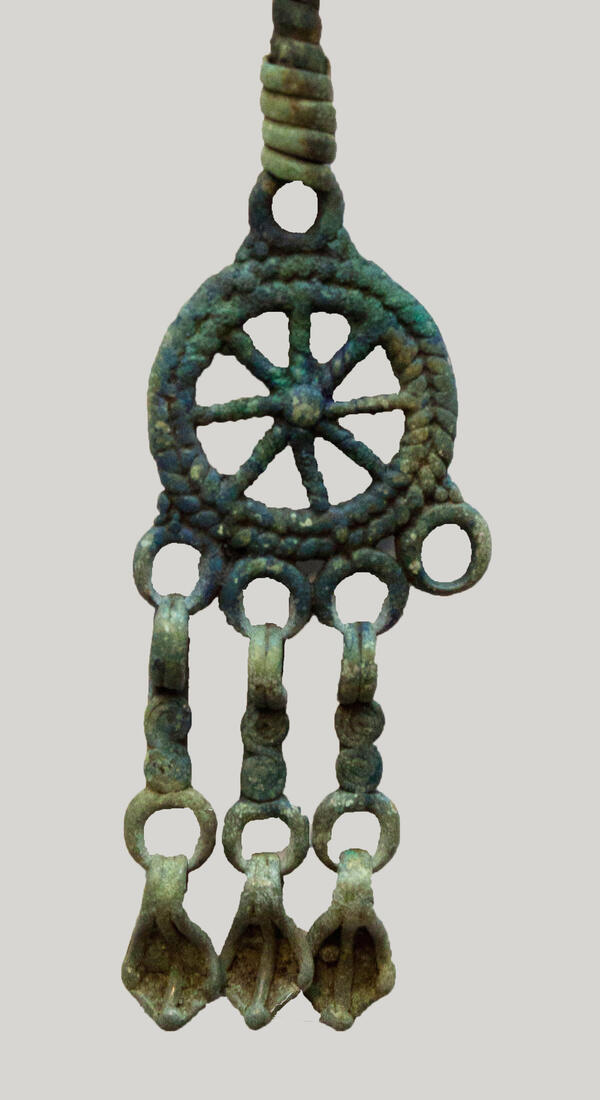Nakosniks (or kosniks) are ancient female plait ornaments that were braided into plaits with a fillet. It was widely used among the Finno-Ugric tribes of the Volga region, Bulgars and ancient Hungarians, as well as many Turkic-speaking peoples until the 20th century. In Muslim Tatar culture nakosniks were an obligatory attribute for women of all ages, and for baptized Tatars they were only a maiden’s ornament. Nakosniks varied as to the complexity and craftsmanship ranging from simple pendants made of coins and plaques to cast openwork pieces with inserts of semi-precious stones.
In the Perm Pre-Urals, ornamental bronze items are found among the burial goods found in the monuments of the the Lomovatovsky culture. Ornaments played an important role in the clothing of local women, they were worn around the neck, on the arms, at the waist and on the head. Nakosniks had clanging pendants, shaped as bells, duck’s feet, or plates, which made a jingling sound as people walked. People believed in the magical powers of metal, which was considered the material of the gods.
Silver was of particular value: it was widely used in religious practices and ceremonies; offerings to the gods were served on a silver platter. Finno-Ugrians perceived copper as animated material, which could not be misplaced by chance, could give signs and even take human form. The tinkling metal charms were polished to a shine: this, according to the beliefs of the time, increased their power over the world of the supernatural. In Old Rus people also believed in the protective power of clinking pendants, so they were worn not only by women, but also men, children, and even animals.
Decorative elements of clothing also showed the age and social status of a woman. Ornaments and amulets for young girls, married and pregnant women were different in terms of design and symbolical meaning. Women’s heads were covered with headscarves, false braids, headbands and braided with ornaments to protect the soul, and hence the body, from ailments.
The nakosnik from the collection of the Komi-Permyak Local History Museum was found in 1953 in a female grave of the Kanevsky burial ground, a monument of the Lomovatovsky culture. The circle frame of this pendant is made in the form of a double “plait”, and attached below are charms with duck’s feet, one of which is missing.
In the Perm Pre-Urals, ornamental bronze items are found among the burial goods found in the monuments of the the Lomovatovsky culture. Ornaments played an important role in the clothing of local women, they were worn around the neck, on the arms, at the waist and on the head. Nakosniks had clanging pendants, shaped as bells, duck’s feet, or plates, which made a jingling sound as people walked. People believed in the magical powers of metal, which was considered the material of the gods.
Silver was of particular value: it was widely used in religious practices and ceremonies; offerings to the gods were served on a silver platter. Finno-Ugrians perceived copper as animated material, which could not be misplaced by chance, could give signs and even take human form. The tinkling metal charms were polished to a shine: this, according to the beliefs of the time, increased their power over the world of the supernatural. In Old Rus people also believed in the protective power of clinking pendants, so they were worn not only by women, but also men, children, and even animals.
Decorative elements of clothing also showed the age and social status of a woman. Ornaments and amulets for young girls, married and pregnant women were different in terms of design and symbolical meaning. Women’s heads were covered with headscarves, false braids, headbands and braided with ornaments to protect the soul, and hence the body, from ailments.
The nakosnik from the collection of the Komi-Permyak Local History Museum was found in 1953 in a female grave of the Kanevsky burial ground, a monument of the Lomovatovsky culture. The circle frame of this pendant is made in the form of a double “plait”, and attached below are charms with duck’s feet, one of which is missing.




